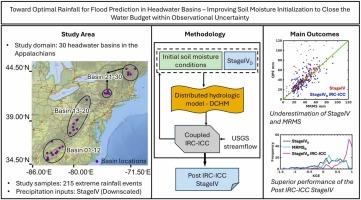Toward optimal rainfall for flood prediction in headwater basins – improving soil moisture initialization to close the water budget within observational uncertainty
IF 5
2区 地球科学
Q1 WATER RESOURCES
引用次数: 0
Abstract
Study region
28 headwater basins along the latitudinal range of the Appalachian Mountains across diverse hydroclimatic and physiographic regions.
Study focus
The objective of this manuscript is to address errors in the initialization of hydrologic models by introducing a physics-based methodology to correct soil moisture (i.e., Initial Condition Correction, ICC) in a manner consistent with the Inverse Rainfall Correction (IRC) methodology proposed by Liao and Barros (2022) to improve Quantitative Precipitation Estimates (QPE). The coupled IRC-ICC framework is demonstrated using a high-resolution hydrologic model for 215 flood-producing events from 2008 to 2024 in 28 headwater basins in the Appalachians.
New hydrological insights for the region
Flood simulations using IRC-ICC QPE, and uncorrected QPE products show a median Kling-Gupta Efficiency (KGE, calculated at 15-minute intervals) of 0.86 versus 0.19, reduction of flood peak timing errors with 90 % versus 20 % of events having peak timing errors within 60 min, and median flood volume errors of 2 % versus −17 %. While the average total precipitation shows a modest increase of 6 % due to ICC, the most significant impact is on spatial variance and on the average maximum rainfall that increases by 68 %. This study establishes the coupled IRC-ICC as a robust general framework for orographic QPE correction and provides a pathway to characterizing and modeling soil moisture uncertainty ahead of extreme precipitation events at high spatial resolution O(100 m).

源头流域洪水预报的最优降水——改善土壤水分初始化,在观测不确定条件下关闭水分收支
研究了沿阿巴拉契亚山脉纬度范围的28个水源盆地,跨越了不同的水文气候和地理区域。本文的目的是通过引入基于物理的方法来校正土壤湿度(即初始条件校正,ICC),从而解决水文模型初始化中的错误,该方法与Liao和Barros(2022)提出的逆降雨校正(IRC)方法一致,以改进定量降水估计(QPE)。利用高分辨率水文模型对2008年至2024年阿巴拉契亚山脉28个源头流域的215次洪水产生事件进行了耦合IRC-ICC框架验证。使用IRC-ICC QPE和未校正的QPE产品进行区域洪水模拟的新水文见解显示,克林-古普塔效率(KGE,以15分钟为间隔计算)的中位数为0.86和0.19,洪峰时间误差在60 分钟内的峰值时间误差减少了90 %和20 %,洪水体积误差的中位数为2 %和- 17 %。虽然由于ICC的影响,平均总降水量适度增加了6 %,但最显著的影响是对空间变异和平均最大降雨量的影响,增加了68 %。本研究建立了耦合IRC-ICC作为地形QPE校正的强大通用框架,并提供了在高空间分辨率0(100 m)下表征和模拟极端降水事件前土壤湿度不确定性的途径。
本文章由计算机程序翻译,如有差异,请以英文原文为准。
求助全文
约1分钟内获得全文
求助全文
来源期刊

Journal of Hydrology-Regional Studies
Earth and Planetary Sciences-Earth and Planetary Sciences (miscellaneous)
CiteScore
6.70
自引率
8.50%
发文量
284
审稿时长
60 days
期刊介绍:
Journal of Hydrology: Regional Studies publishes original research papers enhancing the science of hydrology and aiming at region-specific problems, past and future conditions, analysis, review and solutions. The journal particularly welcomes research papers that deliver new insights into region-specific hydrological processes and responses to changing conditions, as well as contributions that incorporate interdisciplinarity and translational science.
 求助内容:
求助内容: 应助结果提醒方式:
应助结果提醒方式:


